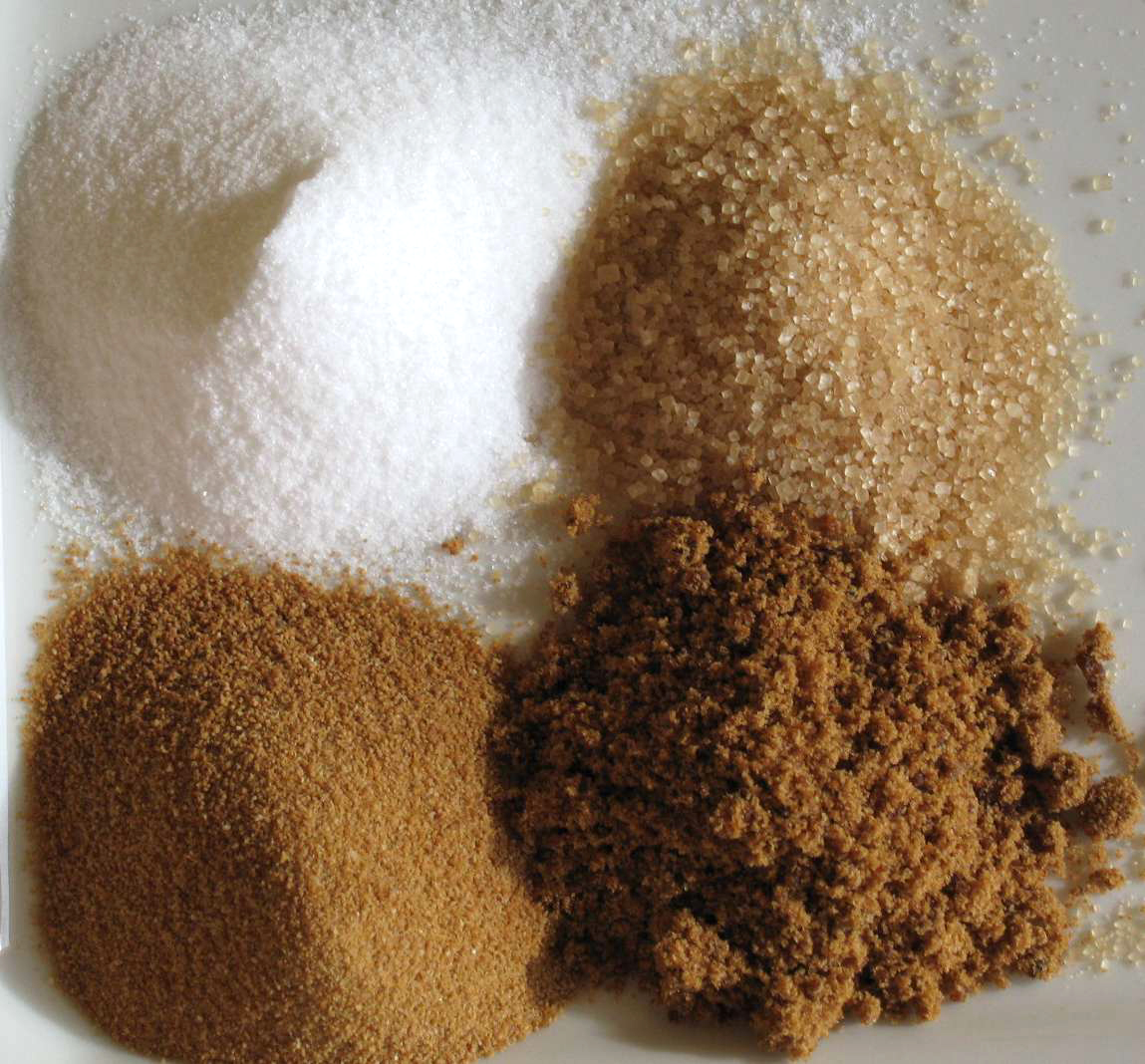
Sugar
Sugar is the generic name for sweet-tasting, soluble carbohydrates, many of which are used in food. Simple sugars, also called monosaccharides, include glucose, fructose, and galactose. Compound sugars, also called disaccharides or double sugars, are molecules made of two bonded monosaccharides; common examples are sucrose (glucose + fructose), lactose (glucose + galactose), and maltose (two molecules of glucose). White sugar is a refined form of sucrose. In the body, compound sugars are hydrolysed into simple sugars.
This article is about the class of sweet-flavored substances used as food. For common table sugar, see Sucrose. For other uses, see Sugar (disambiguation).
Longer chains of monosaccharides (>2) are not regarded as sugars and are called oligosaccharides or polysaccharides. Starch is a glucose polymer found in plants, the most abundant source of energy in human food. Some other chemical substances, such as ethylene glycol, glycerol and sugar alcohols, may have a sweet taste but are not classified as sugar.
Sugars are found in the tissues of most plants. Honey and fruits are abundant natural sources of simple sugars. Sucrose is especially concentrated in sugarcane and sugar beet, making them ideal for efficient commercial extraction to make refined sugar. In 2016, the combined world production of those two crops was about two billion tonnes. Maltose may be produced by malting grain. Lactose is the only sugar that cannot be extracted from plants. It can only be found in milk, including human breast milk, and in some dairy products. A cheap source of sugar is corn syrup, industrially produced by converting corn starch into sugars, such as maltose, fructose and glucose.
Sucrose is used in prepared foods (e.g. cookies and cakes), is sometimes added to commercially available ultra-processed food and beverages, and may be used by people as a sweetener for foods (e.g. toast and cereal) and beverages (e.g. coffee and tea). The average person consumes about 24 kilograms (53 pounds) of sugar each year, with North and South Americans consuming up to 50 kg (110 lb) and Africans consuming under 20 kg (44 lb).[1]
As free sugar consumption grew in the latter part of the 20th century, researchers began to examine whether a diet high in free sugar, especially refined sugar, was damaging to human health. Excessive consumption of free sugar is associated with obesity, diabetes, cardiovascular disease, cancer and tooth decay.[2] In 2015, the World Health Organization strongly recommended that adults and children reduce their intake of free sugars to less than 10% of their total energy intake, and encouraged a reduction to below 5%.[3]
Etymology[edit]
The etymology reflects the spread of the commodity. From Sanskrit (śarkarā), meaning "ground or candied sugar", came Persian shakar and Arabic sukkar. The Arabic word was borrowed in Medieval Latin as succarum, whence the 12th century French sucre and the English sugar. Sugar was introduced into Europe by the Arabs in Sicily and Spain.[4]
The English word jaggery, a coarse brown sugar made from date palm sap or sugarcane juice, has a similar etymological origin: Portuguese jágara from the Malayalam cakkarā, which is from the Sanskrit śarkarā.[5]
Types[edit]
Monosaccharides[edit]
Fructose, galactose, and glucose are all simple sugars, monosaccharides, with the general formula C6H12O6. They have five hydroxyl groups (−OH) and a carbonyl group (C=O) and are cyclic when dissolved in water. They each exist as several isomers with dextro- and laevo-rotatory forms that cause polarized light to diverge to the right or the left.[72]
Consumption[edit]
Worldwide sugar provides 10% of the daily calories (based on an 2000 kcal diet).[105] In 1750 the average Briton got 72 calories a day from sugar. In 1913 this had risen to 395. In 2015 it still provided around 14% of the calories in British diets.[106] According to one source, per capita consumption of sugar in 2016 was highest in the United States, followed by Germany and the Netherlands.[107]
Nutritional value per 100 g (3.5 oz)
1,576 kJ (377 kcal)
96.21 g
0 g
Quantity
Quantity
Quantity
1.77 g
1,619 kJ (387 kcal)
99.91 g
0 g
Quantity
Quantity
Quantity
0.03 g
Various culinary sugars have different densities due to differences in particle size and inclusion of moisture.
Domino Sugar gives the following weight to volume conversions (in United States customary units):[146]
The "Engineering Resources – Bulk Density Chart" published in Powder and Bulk gives different values for the bulk densities:[147]
Society and culture[edit]
Manufacturers of sugary products, such as soft drinks and candy, and the Sugar Research Foundation have been accused of trying to influence consumers and medical associations in the 1960s and 1970s by creating doubt about the potential health hazards of sucrose overconsumption, while promoting saturated fat as the main dietary risk factor in cardiovascular diseases.[114] In 2016, the criticism led to recommendations that diet policymakers emphasize the need for high-quality research that accounts for multiple biomarkers on development of cardiovascular diseases.[114]
Sources[edit]
![]() This article incorporates text from a free content work. Licensed under CC BY-SA IGO 3.0 (license statement/permission). Text taken from World Food and Agriculture – Statistical Yearbook 2023, FAO, FAO.
This article incorporates text from a free content work. Licensed under CC BY-SA IGO 3.0 (license statement/permission). Text taken from World Food and Agriculture – Statistical Yearbook 2023, FAO, FAO.




